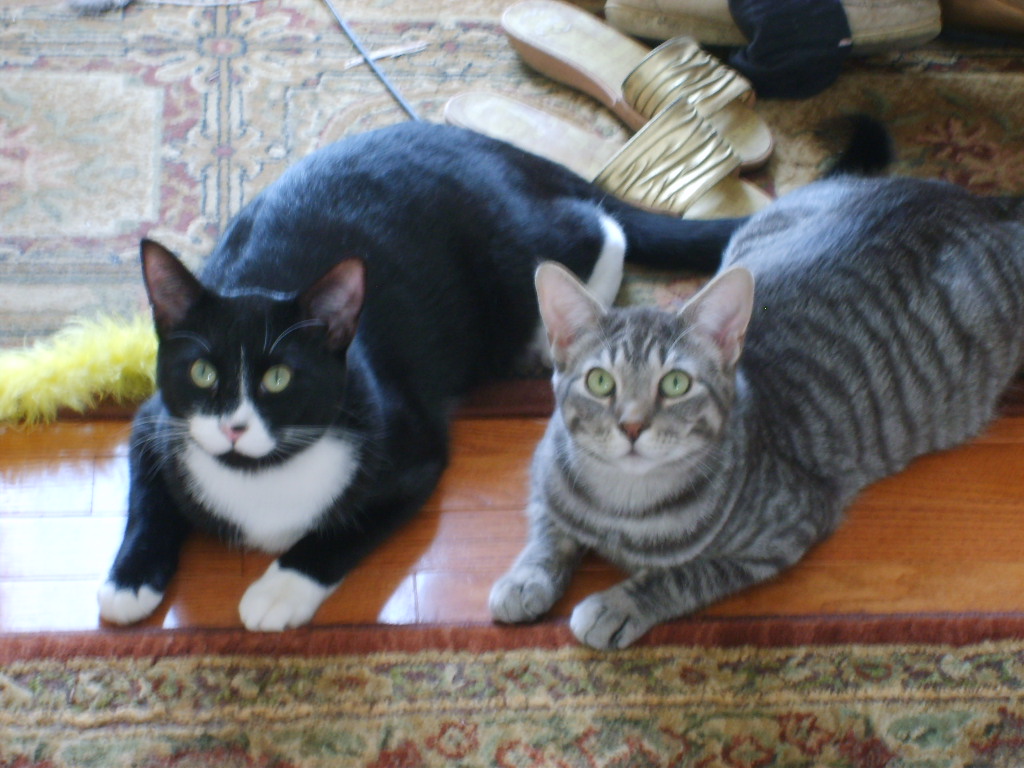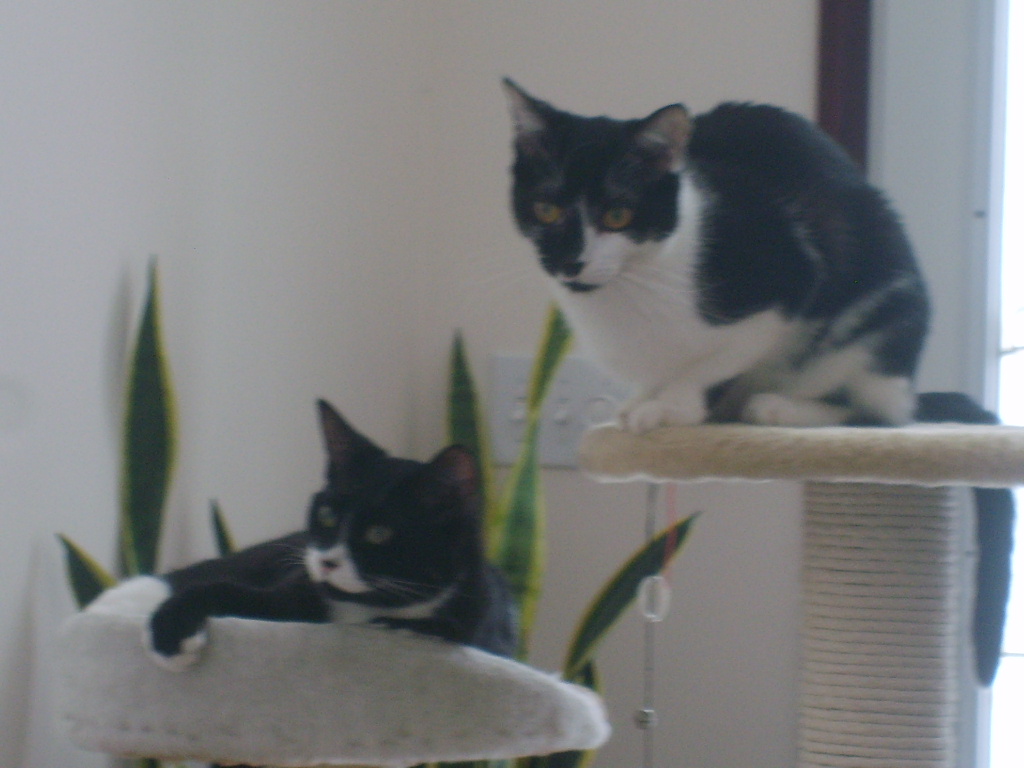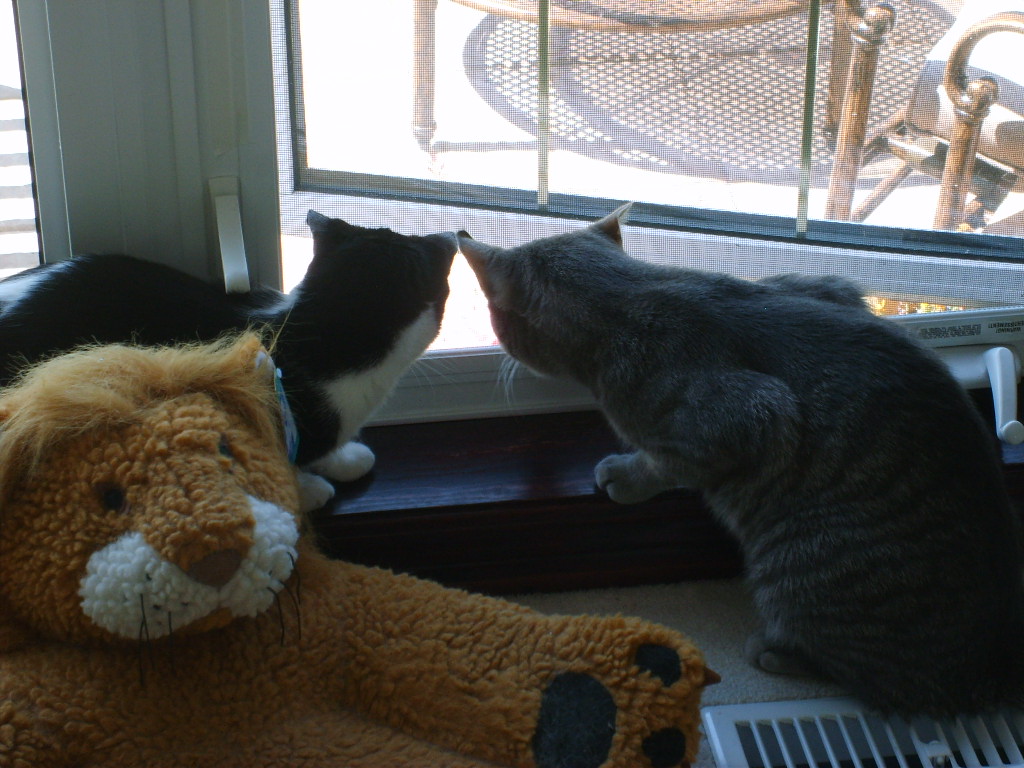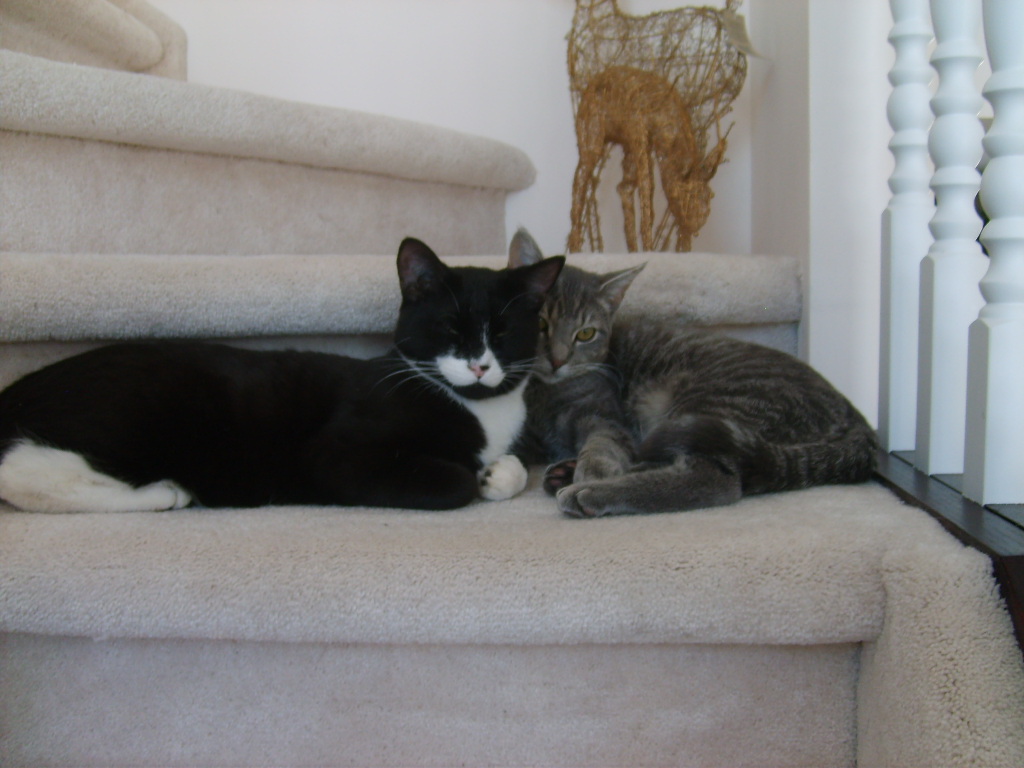|

Angels
4 Animals |
|
 |
|
|
|
 Helping
Cats Get Along Helping
Cats Get Along
(C) Copyright 2009
by Angels4Animals.com
Introducing new
cats to eachother - and getting them truly comfortable with one
another - can sometimes present its challenges.
The good news is
that there are numerous things that can be done to smooth out any
rough edges and ensure that everyone ends up happy and contented. It
may not happen instantly, but when it does it will be SO worth it.
With so many
cats in need of homes, and tragically high numbers of cats being
euthanized every day simply because they have no home of their own,
its a terrible shame not to add another cat to your family simply
for fear of personality clashes when, in fact, its actually not that
difficult to achieve peace and contentment among cats with the right guidance.
This article
explains several very well tested and highly proven techniques which
will enable you to have your cat and adopt another one (or two, or
three...) too!
Time and patience
are sometimes required when introducing unfamiliar cats to eachother.
If the introduction process is handled correctly, the cats will
almost always eventually get along or at least tolerate eachother
(and sometimes they may even become great buddies!).
 *
You must always start very slow when introducing cats to eachother,
especially if these are cats that are not accustomed to living with
other cats. *
You must always start very slow when introducing cats to eachother,
especially if these are cats that are not accustomed to living with
other cats.
* Begin by keeping
the cats in seperate parts of the house for several days - do not let
them come in contact with eachother.
* You want to get
each cat used to the scent of the other cat before allowing them to
meet. For several days before trying to introduce them, you should
"exchange scents". Do this by gently rubbing a towel or
small blanket on the fur of one cat, and then take the towel to the
other cat, allow her to smell it, and leave it with her. Do this in
the reverse with the other cat as well. Repeat this process for a few days.
* Slowly allow the
cats to have more gradual exposure to eachother - as long as they are
not expressing signs of displeasure. After keeping the in seperate
parts of the house for several days and exchanging scents, you can
allow them to spend time on opposite sides of a closed door inside
the home. They will be able to smell eachother under the door, and
may even try playing "foots" under the door if the door
sits high enough off the floor. If there is hissing or growling when
they are on opposite sides of the door, do not move forward with an
introduction. You must give them time to get comfortable with knowing
that there is another cat behind the door. Even if the cats seem
comfortable when seperated by the door, allow at least a few days for
them to be separated in this manner.
* Finally it will
be time to let them have some contact with one another. This must be
done under close supervision. A little hissing and growling is
normal. They are working things out. If there is any swiping or
"boxing", stay close by and be ready to intervene if it
becomes aggressive. A swipe or two may be normal, but if it goes
further than that and they start to scrap, more time is needed and
they will need to be separated again by a door under which they can
smell and hear each other and gradually get used to the other's presence.
* A little trick
that is often effective when letting the two cats meet for the first
time is to get some vanilla extract (sold in the baking department of
any grocery store) and carefully put a little dab on your finger,
then dab it onto the nose of each cat. (Be very carefully not to get
it in the nose, and be very careful not to get it anywhere near the
eyes!!!!). Next, put a dab on the tip of the tail of each cat, and
another dab near the base of the tail of each cat (near the butt).
THEN allow the cats to meet under supervision. In many cases this
allows an introduction to go much more smoothly because now the cats
both smell the same. Part of what cats find disturbing about meeting
other cats is the unfamiliar scent, so by taking this approach, you
are removing that particular issue and it makes the process easier
for everyone involved. Be sure to use a wash cloth to wipe away the
vanilla after the introduction because it can be sticky and messy in
the cats fur (which makes them uncomfortbale as cats like to be very
clean). If you need to seperate them again because the introduction
wasnt a success, repeat the process with the vanilla the next time
you do the re-introduction ( a few days later).
* There is a
product called Feliway which comes in a spray or a plug-in diffuser.
Many vets sell it (inquire with them) and some large pet supply
stores may have it. You can also do an internet search on that name
and find it on the internet. This product emits scents which are very
calming and soothing to cats. It helps relax them in stressful
situations. It can be very helpful when doing cat introductions. If
possible, spray the product (or plug in the diffuser) before you do
the introduction to ensure it goes well. In a worst case scenario, if
you've tried an introduction and are having problems, get your hands
on this product and then try again - it often makes a huge
difference. A similar product is sold in a spray bottle - it is
called Quiet Moments and many pet supply stores sell it. Spray it in
the room when the cats meet and come in contact, and use regalarly
for the first while as they are getting accustomed to eachother. It
may not be as effective as Feliway, but it does help and is often
readily available in local stores.
 *
There are also a couple of other homeopathic products which are very
helpful in reducing stress and anxiety levels during new cat
introductions, and when trying to get cats comfortable in eachother's
presence. Go to http://www.spiritessence.com/ and click on
"products" - consider the following remedies: "Safe
Space for Cats", "grouch remedy",
"peacekeeper" remedy. You simply put a couple of drops into
the cat's wet food, or the water bowl if they drink regularly OR you
can gently rub it into their fur (behind they ears, around their
neck, under the chin). These have a very calming effect on cats who
are unfeeling unsettled due to the presence of another cat. Use
several times a day for best effect. After a couple of weeks
(sometimes even in days) you should see a noticable difference. I
have used these in shelter environments, and also when introducing
bew cats to older cats who have never been exposed to other cats, and
it REALLY does work if you use as directed. Over time you will see a
difference, and often it can be THE thing that really makes or breaks
the success you have with new cat introductions. Also, do an internet
search on BACH Floral Essences. These too are homeopathic remedies
that work wonders in enabling cats to tolerate eachother and get
along if used several times a day as directed until improvement is
seen (usually within a couple weeks). You need to pick the right
remedy for the temperment of the cat or cats. For instance,
"holly" is a good choice if there is jealousy and
resentment between the cats. Read about the uses for the various Bach
Flower Essences and pick the one or ones that best suit the situation
with your cats. A good source for purchasing Bach Flower Essences is
http://www.VitaCost.com. I can tell you for a fact that I have used
these homeopathic remedies with MANY cats that were uncomfortable or
downright aggressive with other cats and they WORK if used regularily
and as directed, and also when combined with the gradual approach to
contact as descirbed above. *
There are also a couple of other homeopathic products which are very
helpful in reducing stress and anxiety levels during new cat
introductions, and when trying to get cats comfortable in eachother's
presence. Go to http://www.spiritessence.com/ and click on
"products" - consider the following remedies: "Safe
Space for Cats", "grouch remedy",
"peacekeeper" remedy. You simply put a couple of drops into
the cat's wet food, or the water bowl if they drink regularly OR you
can gently rub it into their fur (behind they ears, around their
neck, under the chin). These have a very calming effect on cats who
are unfeeling unsettled due to the presence of another cat. Use
several times a day for best effect. After a couple of weeks
(sometimes even in days) you should see a noticable difference. I
have used these in shelter environments, and also when introducing
bew cats to older cats who have never been exposed to other cats, and
it REALLY does work if you use as directed. Over time you will see a
difference, and often it can be THE thing that really makes or breaks
the success you have with new cat introductions. Also, do an internet
search on BACH Floral Essences. These too are homeopathic remedies
that work wonders in enabling cats to tolerate eachother and get
along if used several times a day as directed until improvement is
seen (usually within a couple weeks). You need to pick the right
remedy for the temperment of the cat or cats. For instance,
"holly" is a good choice if there is jealousy and
resentment between the cats. Read about the uses for the various Bach
Flower Essences and pick the one or ones that best suit the situation
with your cats. A good source for purchasing Bach Flower Essences is
http://www.VitaCost.com. I can tell you for a fact that I have used
these homeopathic remedies with MANY cats that were uncomfortable or
downright aggressive with other cats and they WORK if used regularily
and as directed, and also when combined with the gradual approach to
contact as descirbed above.
* The bottom line
is that with patience and perserverance, and the guidance provided
above, it really IS possible for cats to get along even if it isnt
looking promising at the start. Dont give up. Your cats need your
committment to them to help them work it out. Never just toss them in
a room together and force them to work it out on their own. Take a
leadership role, with understanding and compassion, and guide them
through it. You can do this! You're the human!
 Whatever
you do, don't give up. Make your committment to all of the cats
involved. Far too many cats are given away or given up because their
owners werent willing to make the effort needed to help the cats work
it out. Any time a cat who has a home is given up or given away it is
a tragic situation because there is such a huge problem with a lack
of enough homes for cats. This is why so many are euthanized, or end
up suffering on the streets. Even if you find a home for a cat you
decide to give up, it takes away a potential home from another cat -
because there are only so many homes to go around. And sadly, many
cats who are rehomed by their owners ultimately end up on the streets
because they've run away in hopes of finding their former family, or
they are abandoned by the new owner because they were never truly
wanted in the first place. Whatever
you do, don't give up. Make your committment to all of the cats
involved. Far too many cats are given away or given up because their
owners werent willing to make the effort needed to help the cats work
it out. Any time a cat who has a home is given up or given away it is
a tragic situation because there is such a huge problem with a lack
of enough homes for cats. This is why so many are euthanized, or end
up suffering on the streets. Even if you find a home for a cat you
decide to give up, it takes away a potential home from another cat -
because there are only so many homes to go around. And sadly, many
cats who are rehomed by their owners ultimately end up on the streets
because they've run away in hopes of finding their former family, or
they are abandoned by the new owner because they were never truly
wanted in the first place.
So rather than
just give up and give a cat away if your cats aren't getting along,
stick it out and work with them. It is such a rewarding experience
when you do this and they ultimately end up getting along. You'll
know you've done good!
Remember!
Go slow and have patience. Some hissing and growling is VERY normal
and is not cause for alarm - it is a natural process they need to go
throw and they'll get past it with a little time. Give all the
kitties involved lots of love and attention so they know they need
not feel threatened by the other cat in terms of their place in the
home and in your life. If things look like they're getting out of
hand (meaning more than a few swats or a little boxing), seperate
them for a few more days (or however many are needed) and start the
process over again.
In a future
article we'll discuss what to do if you already have cats who aren't
fond of one another.
Thank you for
caring for your Cats!!

Back
to Angels4Animals
|